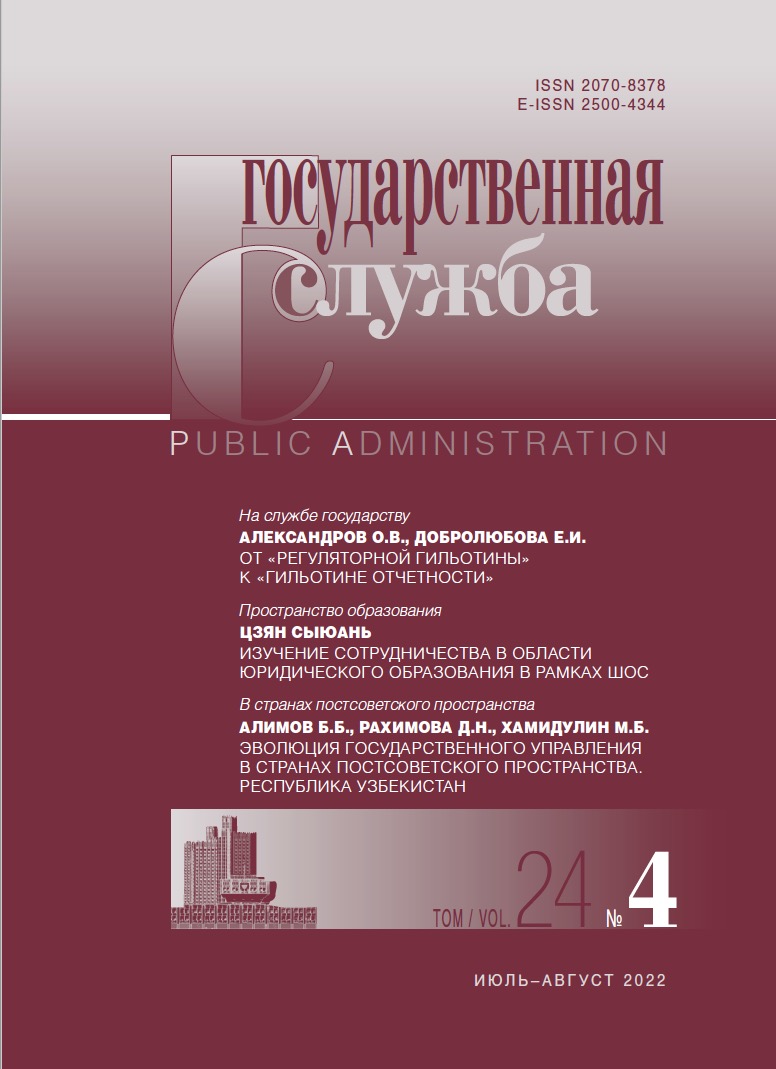Recommended link to article:
MAXIM VALERYEVICH FIRSOVа
аNational Research Center «Kurchatov Institute»
DOI: 10.22394/2070-8378-2022-24-4-6-12
Abstract:
The study defines the main directions for improving approaches to performance evaluation for the heads of territorial bodies of federal executive authorities (FEAs). The author analyzes the shortcomings of the existing evaluation and performance criteria system and examines approaches to understanding the public administration efficiency by domestic and foreign scientists. The materials of the study offer ways for administrative and legal consolidation of performance indicators, as well as methods for their evaluation based on interactions of federal executive bodies with scientific organizations. The relevance of the study is defined by the existing gap between modern scientific achievements in the field of performance evaluation for public administration and the current administrative acts in this area. The objects of the study are administrative and legal norms governing the indicators for the effectiveness of the heads of territorial bodies, ways to assess them, the existing shortcomings of legal regulation, and ways to overcome them. The scientific novelty of the study lies in the idea of the client-oriented approach, which revises the approaches to evaluate the performance by replacing quantitative criteria of effectiveness with qualitative. The goal of the study is to introduce a scientifically based approach and improve the administrative and legal regulation of the existing system for evaluating the performance of the heads of territorial bodies of federal executive authorities based on a comprehensive legal, managerial and comparative analysis.
Keywords:
civil service, state bodies, territorial bodies, federal authorities, performance criteria, key performance indicators, performance evaluation
Received:
April 28, 2022
References:
Asriyants K.G. Criteria and methods for assessing the effectiveness of civil servants. Industrial’naya ekonomika. 2021. No. 3. P. 17–22. In Russian
Bogdan N.N., Glinyanov M.A. Approaches to assessing the effectiveness and efficiency of professional activities of civil servants. Razvitiye territoriy. 2020. No. 4 (22). P. 18–24. In Russian
Borshchevsky G.A. Evaluating the performance of public civil servants. Upravlencheskiye nauki. 2012. No. 2 (3). P. 8–15. In Russian
Chazova I.Yu., Israilov M.V. Evaluating the effectiveness of public authorities. Vestnik Udmurtskogo universiteta. 2019. No. 6. P. 776–785. In Russian
Latham G.P., Borgogni L., Petitta L. Goal setting and performance management in the public sector (translation from English by E.G. Zvereva). Voprosy gosudarstvennogo i munitsipal’nogo upravleniya. 2011. No. 4. P. 72–91. In Russian
Maklakova E.A. The problem of assessing the effectiveness of civil servants in modern conditions. Tsarskosel’skiye chteniya. 2017. No. 3. P. 197–201. In Russian
Merinova A.A. Personnel technologies for assessing the effectiveness of civil servants. Yevraziyskiy nauchnyy zhurnal. 2021. No. 9. P. 12–15. In Russian
Nomden K. The evolution of human resources management in public administrations of the European Union. EIPASCOPE. 2000. No. 1. P. 1–3. In French
Okhotsky E.V. Public administration: modernizing the current model of state management. Vestnik MGIMO Universiteta. 2014. No. 3 (36). P. 115–127. In Russian
Rassokhina V.A., Rossinskaya M.V. Ways to assess the effectiveness of work of civil servants. Vestnik magistratury. 2016. No. 12-5 (63). P. 81–84. In Russian
Vasilyeva E.I., Zerchaninova T.E., Ruchkin A.V. Evaluating the effectiveness of civil servants. Upravlencheskoye konsul’tirovaniye. 2016. No. 4 (88). P. 14–26. In Russian
Articles in Open Access mode are published under the Creative Commons Attribution 4.0 International (CC BY) license.

